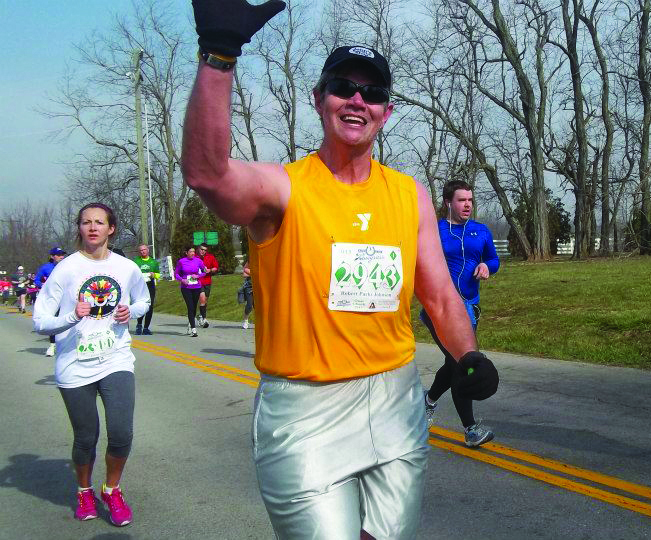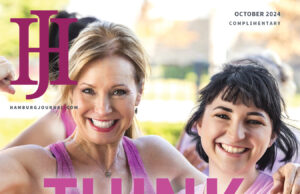by Robert Parks Johnson
I started training for a May 17 10K race back in the icy days of late March. One morning in early April, after teaching a water fitness class, (the lowest of low impact aerobics,) I felt a sort of popping in my left knee.
My 54-year-old joints do the snap, crackle, pop quite a bit in the morning, so I didn’t think much of it, but when I climbed up the ladder and onto the deck, the added gravity let me know this was no ordinary Old Guy noise. A mild ache started that morning, just under the interior side of the patella, and even now, sitting at the keyboard four months later, it is still there. I started treating it with RICE: rest, ice, compression, and elevation. I even watched the Cats lose the NCAA final game to UConn with my leg iced, wrapped, and up on a cushion. But it didn’t seem to get any better.
My race training changed gradually from running to jogging to limping to walking. I noticed that low impact movement seemed to help, but the knee would stiffen painfully when I sat still, even for just a few minutes. I made it to race day for the sake of the kids I was mentoring, but have not run since then. Two weeks ago, I saw the doc. She took some x-rays and found a little arthritis and some compression in the interior capsule of the left knee.
So the good news is there’s no soft tissue damage and nothing requiring surgery. The bad news is that there isn’t an easy way to make the pain go away. I’ll be following up with the sports medicine clinic, but for the present, a painful knee is just going to be part of the deal for me.
Lexington’s first Full
May 17, 2015
I was determined not to let pain stop my progress toward my weight loss goals for the year or my May 2015 Marathon, so I walked instead of running. I’ve discovered some big differences between walking and running, which I’ll be exploring at length in future columns, but the most practical difference is that walking takes a lot longer. I had been training at 11-12 minute miles. Each walking mile can take me as much as 20 minutes. On the other hand, I have a lot less time to snack. You can always find a silver lining.
I found that I felt much better after teaching in the pool or the exercise studio. Soaking in the whirlpool after a workout seemed to give comfort as well. I can’t take a lot of aspirin because of the blood thinners I’ve been on since chemo/radiation buggered my platelets, but the folks who make acetaminophen are always happy to see me.I also bought a small heating pad for post workout recovery. After a month of this regimen, the pain started to lessen and I began planning for the Magic Mile I had on my training schedule.
Here is how I planned the splits for my 4 mile training run:
• One mile of brisk walking
• One mile of 0:15/0:45 run/walk intervals
• One mile run (The Magic Mile)
• One mile of 0:15/0:45 run/walk intervals
I followed this with 30 minutes of deep water running at the Y, a 15-minute soak in the whirlpool, then I drove home for some over-the-counter pain relievers, a nap, and about an hour with the heating pad.
How did it go? Better than I’d hoped. I ran the Magic Mile in 11:31, about 2 minutes slower than my personal best, but let’s face it: I am a long way from my best today. More importantly, I ran without pain for the first time since April. I’m not ready to run regularly yet: I calculated my training pace at 16:58, which is a steady 3.5 mph walk. This morning, the knee was stiffer than it has been in a while, but a 3 mile hike downtown and back made it happy again.
Eyes on the Prize:
Raising $10,000 for LS@Y
Looking into my crystal ball, I see 14 miles on the schedule this week, which should be easy to reach. I’ll be skipping the Independence Day Bluegrass 10,000 for the first time in several years, but still have hopes for the 5K Midsummer Night’s Run in August. I wanted to have a couple of Half Marathons under my belt before May, but have not committed to any yet. My real goal for my marathon is to raise $10,000 for LIVESTRONG at the YMCA, and if that means saving my knees for one last long push, then that’s what I’ll do. I don’t want to do more damage to my body; I want to be smart; I’m getting the best advice I can, and being very conservative. Dropping pounds can only help, and I’d like to lose about 25 more this summer. In future posts, I want to talk about how the pain is affecting my plans, my form, and my mental discipline.
I want to finish with something my shrink is teaching me: pain is a part of life. The only way to live without suffering is to keep yourself numb: that’s how an addict thinks, and I’ve seen enough to know that addiction is a doomed strategy. The key to living a rich, full, and meaningful life is knowing your values, committing to action that leads you toward them, and embracing both the pain and joy that are part of your life’s journey.
You can’t obliterate suffering. You can’t ignore it. But you can learn to accept it when it comes, to make room for it in your life, and carry it along with you as you travel toward becoming the person you want to be.
And that’s the thinking I hope can keep the Fat Man Running: at least for a little while longer.
Program Building: Goals are the Bridge
For all but the most self-satisfied among us, there is a gap between where we are and where we want to be. Goals can help us to bridge that gap. I’ll offer a couple of my running goals as examples in the hope that they may help you to set your own. Remember the steps that led me here:
• Know who you are: I’m a runner whose mental health plan includes regular workouts, whose age and condition requires frequent recovery days, and whose tendency toward over-training can lead me to wear myself down.
• Know why you’re running: I love the peaceful feeling I get when I’m running, no matter how tough the hills or how much my body hurts. I love the way my leg muscles feel when I flex them. I love the solitude of running, but I also enjoy the company of runners. I love the feeling that I keep getting better. Running makes me feel more alive. It’s pretty clear that my running isn’t about competing. I’m not really thinking about winning when I run. There aren’t that many people I can keep up with, let alone beat in a race. My goals are much more internal. I want to be faster. I want to be stronger. I want to run long distances without hurting myself. I want to keep doing things I’ve never done before. I’ve set three goals for 2013, with all that in mind.
• Run a sub 60 minute 10K
• Finish two marathons in
under 6 hours
• Log 1000 training miles
Each of these is pretty ambitious for me. Each meets the SMART goal criteria. And they are just far enough out of my comfort zone to be a little scary. Reaching them is going to require me to make a serious commitment to running for the next six and a half months. My program is what that commitment looks like in practical form. The details of that program will be the subject of our next episode. ‘Till then:
Sleep well. Eat clean. Lift heavy. Run hard.












